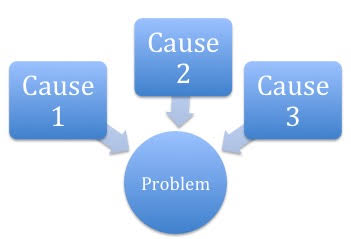Evidence-Based Practice in Rehabilitation
A problem of practice topic may include the following things:
- Specific to a patient population (e.g. biomechanical disability, balance, mobility, dexterity, etc.);
- Related to an intervention (e.g., effectiveness testing, selecting appropriate interventions, design-redesign);
- More generally associated with clinical practice (e.g. cost, efficiency, confidence in administration, education, sustainability, business practice needs, change in practice norms, marketing, continuous improvement systems, etc.);
- Related to professional issues (e.g., continuing education, government policy issues, self-care like compassion fatigue, etc.); or
- A research proposal for any of the previous listed topics.
Introduction
Sometimes we are faced with problems other than patient-specific interventions. Like those, we need to clearly understand the problem, conditions and causes that create the problem to begin with. To define the problem of practice, consider the following two points.
1. Understand the context
-
Consider the problem from multiple perspectives: the patient, physician, nurse, CPO, therapist, counselor, employer, insurer, caregivers, manufacturers, front office staff, technicians, and any other individuals who may have a stake in the problem and it’s potential solution.
-
If the problem is related to a specific population, consider describing all categories of the ICF.
2. Define and understand the problem
-
Consider the complexity and level that the problem exists
-
Is it related to diagnosis, specific personal or environmental factors, specific practitioner issues, or something at the level of the health service, policy or social context?
-
“…having more than one level challenges us to use more than one theoretical approach.” (Campbell et. al.)

-
-
Consider all of the potential causes and pathways
-
Draw connections between the causes and problem
-
-
What does the evidence (empirical or anecdotal) tell us?
-
Is there a problem with the innovation?; Is there a problem with the way the intervention gets implemented?; Is there a lack of money or organizational structure?; Is there difficulty generalizing the research findings to practice situations?; Is there a lack of time, skills or resources?
-
What is the extent of the problem?
-
-
Avoid the "zone of wishful thinking". Consider whether the intervention to address the problem of practice is actionable. Is it something that is doable and achievable? Sometimes the problem of practice is too broad. Consider ways to break the problem down into parts - then tackle just one part of the problem.
-
Recognize that defining the problem of practice and selecting the appropriate intervention is an iterative process
References
This page was compiled using two primary sources:
- Designing and evaluating complex interventions to improve health care. Campbell, Neil C; Murray, Elizabeth ; Darbyshire, Janet ; Emery, Jon ; Farmer, Andrew ; Griffiths, Frances ; Guthrie, Bruce ; Lester, Helen ; Wilson, Phil ; Kinmonth, Ann Louise. BMJ, 3 March 2007, Vol.334(7591), p.455.
- Framework for design and evaluation of complex interventions to improve health. Campbell, Michelle; Fitzpatrick, Ray; Haines, Andrew ; Kinmonth, Ann Louise ; Sandercock, Peter ; Spiegelhalter, David ; Tyrer, Pete. BMJ, 16 September 2000, Vol.321(7262), p.694.
